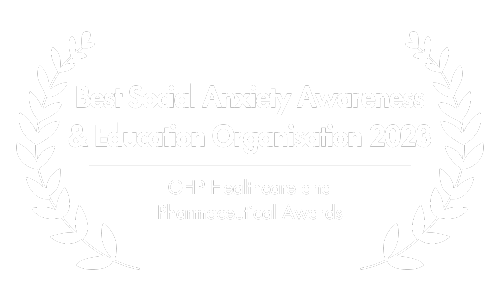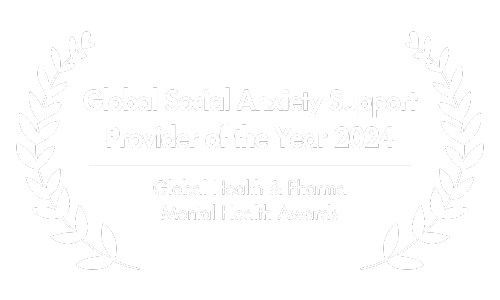How to Help a Student With Social Anxiety?
Social anxiety disorder (SAD), the excessive fear of being judged and humiliated, is a sadly common phenomenon among students.
While about 6% of children are affected by the condition (Chavira, Stein, Bailey, & Stein, 2004; Ruscio, Brown, Chiu, Sareen, Stein, & Kessler, 2008), numbers quickly escalate with the beginning of puberty, with the disorder peaking around age 12 (Kessler et al., 2005).
A 2017 study by Mekuria and colleagues found that as many as 27.5% of regular school students in 11th and 12th grade met full diagnostic criteria for SAD.
Although cases in this specific study were particularly high and may vary between countries, it can be assumed that a classroom of twenty adolescents or young adults includes between two to five students with marked social fears.
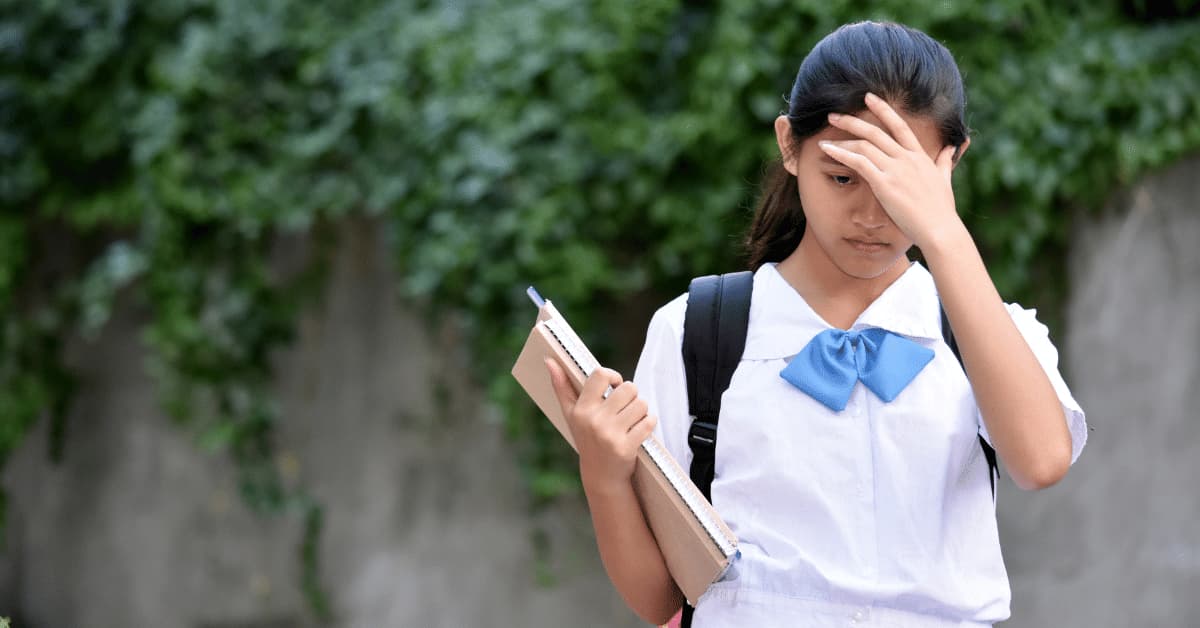
Social anxiety disorder, also called social phobia, neither refers to the personality trait of introversion nor to the feelings of insecurity that are commonly experienced by the majority of teenagers.
Instead, they describe a mental health condition that needs to be taken seriously and requires special attention.
Many parents underestimate the extend of their child’s dilemma (Masia, Klein, Storch, & Corda, 2001). Contrary to popular belief, most of the affected kids do not grow out of these excessive concerns naturally.
Failure to identify the disorder and intervene at an early age can have detrimental effects on the students’ mental health.
If left untreated, SAD tends to have a chronic course throughout the lifespan (Yonkers, Dyck, & Keller, 2001; Yonkers, Bruce, Dyck, & Keller, 2003) and often leads to additional mental health conditions, such as depression and substance abuse (Wittchen, 2000; Sonntag, Wittchen, Höfler, Kessler, & Stein, 2000).
This comprehensive guide is directed at teachers and professors of socially anxious students.
We will cover important caveats related to social anxiety in the academic realm and provide useful, practical strategies to help affected students thrive and potentially reduce their social fears along the way.
Social Anxiety in Students: An Introduction
The main feature of social anxiety disorder is the excessive concern of being negatively evaluated, judged or rejected in social settings (American Psychiatric Association, 2013).
As you can imagine, adolescence represents an especially difficult chapter for affected individuals, given that recognition, respect and acceptance among peers play a crucial role during this developmental stage.

The fear of being judged often leads teenagers with SAD to hide their condition (Ryan & Masia Warner, 2012). This, in turn, tends to increase their concerns of being found out and can lead to a self-reinforcing, vicious cycle.
As a result, social phobia typically leads to significant functional impairment .
Among the most common short-term consequences are (Beidel, Turner, Morris, 1995; Beidel, Turner, Morris, 1999; Connolly & Bernstein, 2007):
- fewer and less satisfying friendships,
- avoidance of social interactions (such as starting conversations, participating in clubs or sports teams),
- refraining from engaging in classroom activities (group work, answering questions, etc.).
As we have mentioned before, the long-term consequences can be detrimental, with affected people often developing depression, substance abuse, or other mental health disorders (Kessler, Stang, Wittchen, Stein, & Walters, 1999; Wittchen, 2000; Sonntag, Wittchen, Höfler, Kessler, & Stein, 2000).
Noteworthy is also the remarkably large number of suicidal attempts in people with concurrent SAD and depression (Wunderlich, Bronisch, & Wittchen, 1998).
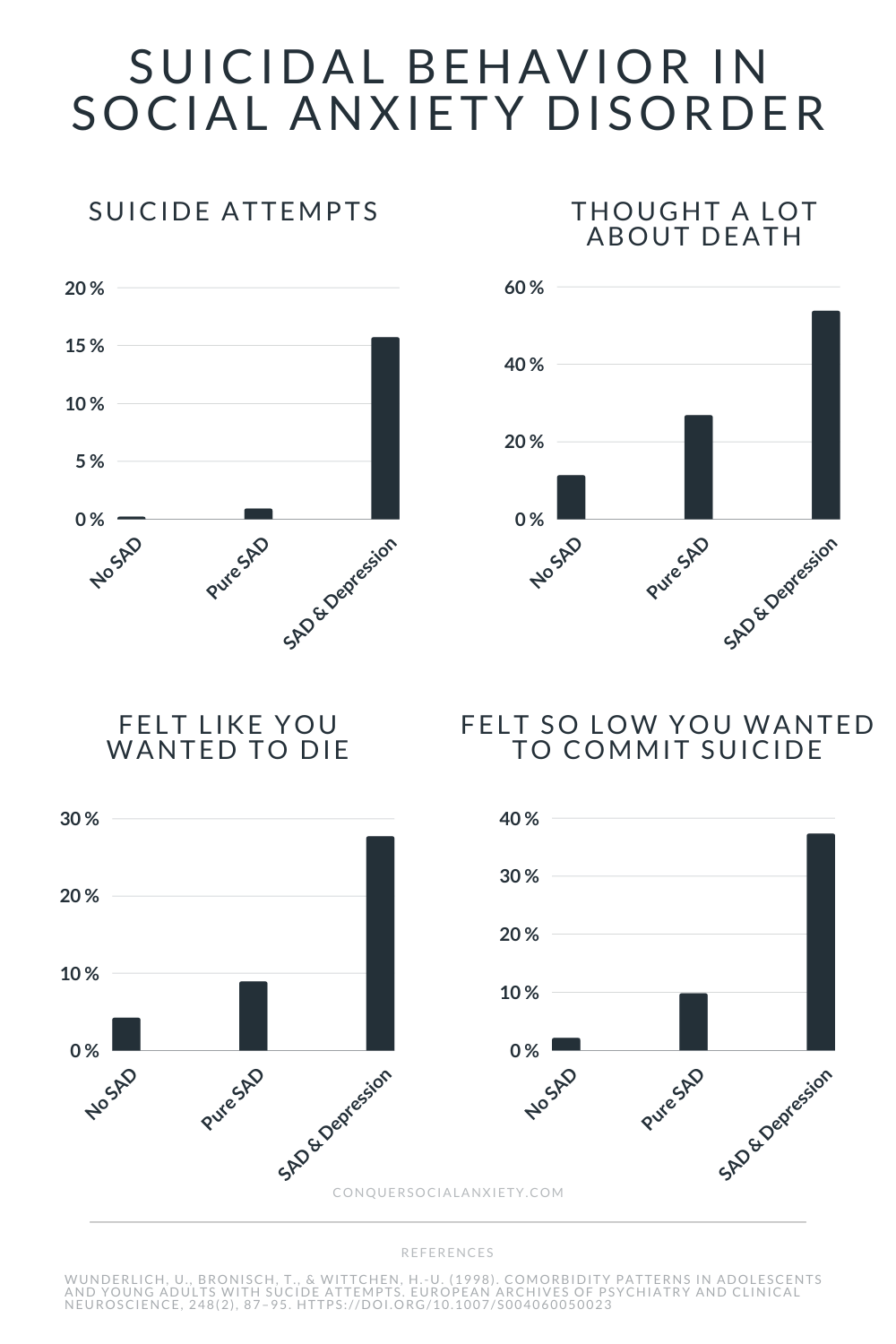
Equipped with this information, you may assume that there are established medical programs that screen for SAD during childhood and early adolescence.
However, the condition is still largely overlooked, remains underdiagnosed and is therefore not treated nearly enough (Pöhlmann, Döbbel, Löffler, Israel, & Joraschky, 2009).
In fact, fewer than 20% of teenagers with anxiety disorders receive professional treatment for their condition (Merikangas et al., 2011).
Social anxiety causes many students to drop out of school prematurely, to not pursue an academic career and to stay below their professional potential on a large scale (Van Ameringen, Mancini, & Farvolden, 2003).
Given that students spend most of their time at school or university, an environment which is intrinsically social, these institutions represent a crucial factor regarding the development, maintenance, and potential improvement of their students’ SAD.
Working with these kids on a daily basis, educators should take the potential struggle their students may be going through into account and be flexible with their methodology, adjusting it to the particularities of affected students.

Like this, you as a teacher can have a decisive impact, not only on your students’ academic accomplishments, but also on the development of their social abilities, their mental health and their life satisfaction in general.
This is not to say that you as a teacher should assume the role of the students’ therapist.
However, counting with practical tools and strategies which allow you to adjust the learning environment in a way that enables your socially anxious students to actively participate and thrive is invaluable.
Let’s have a look on the importance of schools, universities and educators for this matter.
The Crucial Role of Schools & Teachers
The social nature inherent to SAD makes group treatment an ideal intervention for people with social phobia.
Given that the symptoms of insecurity arise in natural, everyday settings, therapists typically try to recreate such social situations with their patients.
However, this can be a challenging task in the clinical context, as patients’ diagnoses often differ and scheduling among clients often results difficult (Ryan & Masia Warner, 2012).
Additionally, such opportunities only apply to those who are identified as SAD sufferers and properly diagnosed as such.
As we have pointed out before, most cases of affected students are still overlooked (Kashdan & Herbert, 2001), which means they rarely receive professional help (Essau, Conradt, & Petermann, 1999).
As schools and universities commonly contain many socially anxious students and inevitably provoke situations that cause social distress, the chances of identifying affected individuals in this environment are pretty good.

Furthermore, schools and universities provide an ideal setting for a real-world treatment approach to social anxiety (Ryan & Masia Warner, 2012). For example, students can practice commonly avoided scenarios, such as:
- participating in class (asking or answering questions, sharing their opinion, etc.),
- interacting with authority figures (teachers & professors),
- socializing with peers,
- eating or drinking in public,
- giving presentations,
- reading out loud in front of larger groups, among other situations.
Experts believe that interventions carried out in real-world settings can improve treatment effectiveness and its gains can more readily pass over to other life domains (Ryan & Masia-Warner, 2012).
Educating teachers about social phobia, as well as enabling them to make fruitful treatment referrals for their students, can lead to a much needed increase in successful interventions.
Let’s have a look on some signs that could indicate that one of your students may suffer from social anxiety.
How to Identify Social Anxiety in Students?
Given the nature of the disorder, socially anxious students typically follow instructions and keep mostly quiet during class.
Because they do not tend to be not interruptive, it can be challenging to spot the signs of social anxiety in the classroom (Ryan & Masia Warner, 2012).
This, of course, differentiates SAD from behavior disorders, which are often apparent right away.
As we have mentioned before, students with social phobia commonly try to hide their insecurity. Therefore, you may see a happy face, which can act as a disguise to the internal experience of fear and insecurity.

The following phenomena can be seen as first indicators that a student may suffer from social anxiety:
- The student is unusually quiet and does not actively participate in classroom activities.
- The student stays mostly for themselves and does not engage with peers during breaks.
- The student typically uses their smartphone while their peers socialize.
- The student remains passive when subgroups are being formed.
- The student avoids direct eye-contact or maintains it only for brief moments.
- The student “disappears” during class – either physically or by avoiding participation.
- When the students speaks during class, answers are kept as brief as possible.
- The student gets notably irritated before and during presentations (or similar performance situations).
- The student displays physical signs of arousal and anxiety when being the center of attention (shaky voice, trembling hands, facial blushing, sweating, shortness of breath, etc.).
- The student has a hard time concentrating on the task at hand when being observed (increased self-consciousness).
- The student leaves the class to use the restroom when performance/observation situations may arise (“Who is going to read their homework assignment to the class?”)
- There is a strong discrepancy between the student’s non-participation during class and the quality of their written assignments.
Keep in mind that there is a “performance only” subtype, which refers to individuals who only experience social anxiety during performance situations.
This means that some students may be social butterflies, but become overwhelmed and freeze when having to present something to the group.
Although such social awkwardness may be uncharacteristic for these students, it is important to take their sudden anxiety reaction seriously.
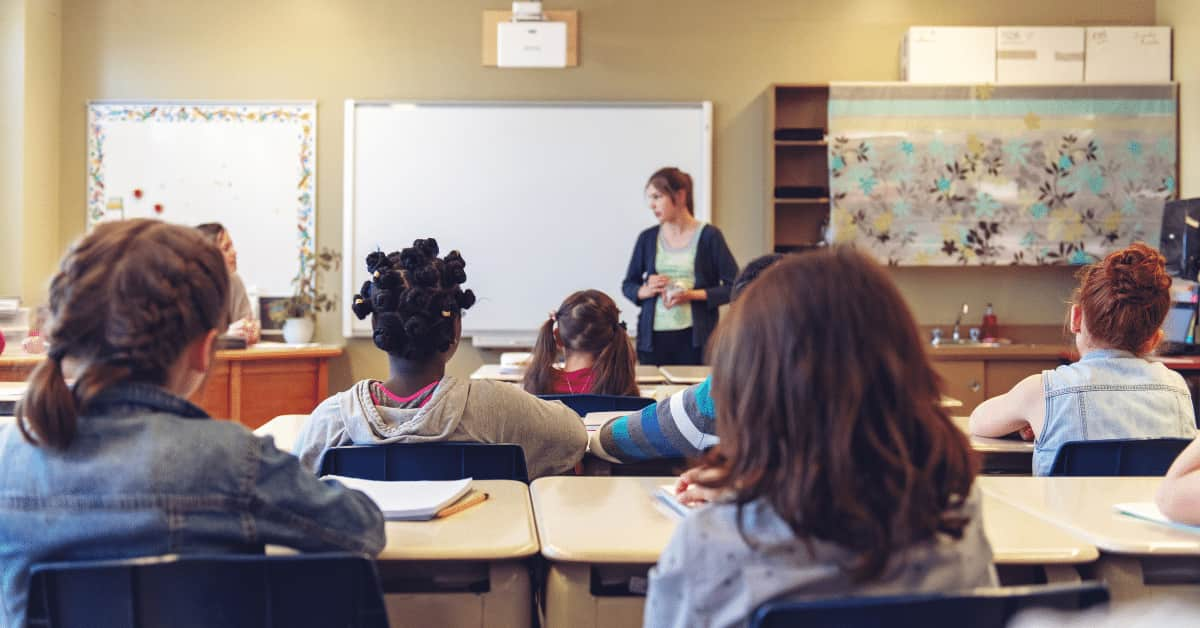
Now that you have a general idea of how social anxiety might manifest in your students, let’s have a look on some practical strategies you can employ to help them thrive in class.
Strategies to Help Students With Social Anxiety
The following tools and strategies are general recommendations for teachers who suspect that one or several of their students suffer from social phobia.
Keep in mind that every person is different, meaning that you should closely monitor the effects your methodology may have on each individual.
Also, remember that you are the child’s teacher, not their therapist. Your interventions should be in alignment with your role as an educator.
With that said, let’s have a look on some useful tips for working with groups that contain students with social anxiety.
(1) Do not infer that the student is disinterested in your class.
It is natural to assume that those who do not participate in a conversation are not interested in it. However, this is not necessarily the case.
Socially anxious people often suffer from being judged as distant, reserved, arrogant or disinterested. Yet, in most cases, this could not be further from the truth.
If you suppose that one of your students may suffer from social anxiety, you can also assume that they would participate more actively in class, if they were not inhibited by their social fears.
(2) Be careful with putting the student on the spot.
Many people with social phobia dread being the center of attention. Keep in mind that showing up to class is a big step for most students with SAD.
Be careful who you put on the spot. While some students may need this type of stimulation, those with social anxiety may start fearing your class and stay at home as a result.
Instead, look for ways they can choose to participate if they feel up for the task.
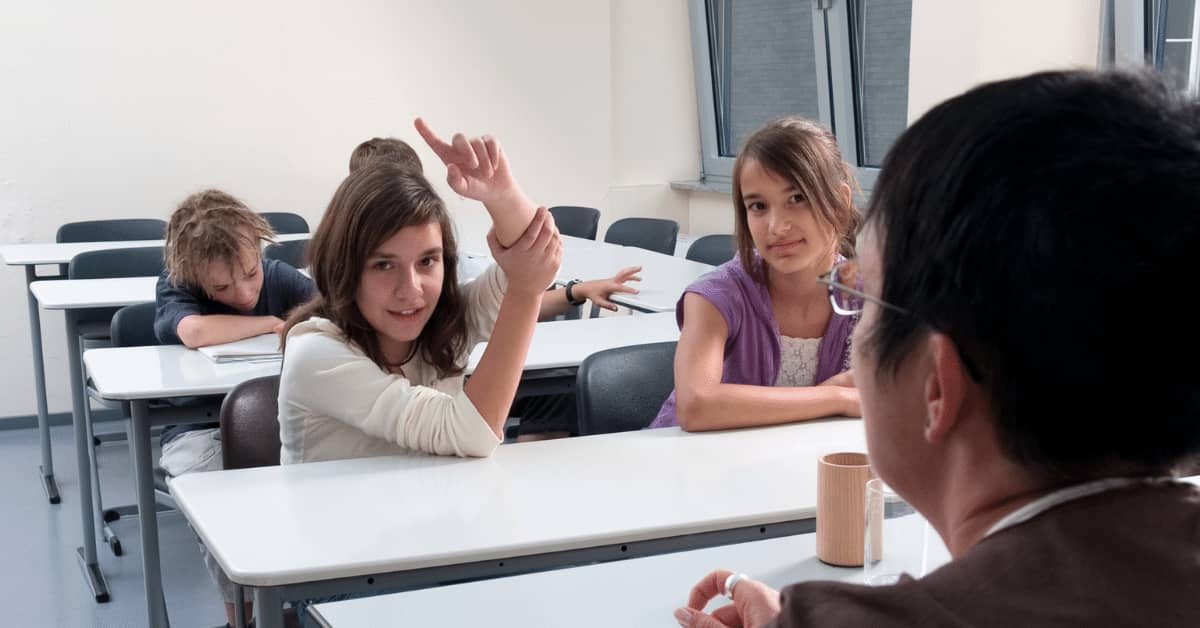
(3) Facilitate the discussion in a way that allows the student to participate.
In each group you have individuals who talk a lot and you have those who remain silent most of the time.
Your task as a teacher is to lead the discussions in a way that allows the shyer students to actively participate in the process.
Sometimes, students with SAD are unsure about whether or not to ask a question or voice their opinion. Then, one of the extroverts adds their 2 cents and the socially anxious student decides to stay quiet, once again.
Make sure to provide space to participate for those who usually remain mute, letting them know that their participation is valuable and desired.
(4) Ask the student simple questions that do not require extensive answers.
Some students with social anxiety benefit from being pushed a little. If you do this carefully, you can increase the students’ participation dramatically.
For example, asking the student simple ‘yes-or-no‘ questions, or whether or not they agree with a specific idea, can make the process of speaking up much easier.
A main reason for this is not only the slight push you give the student, but also the control they have over the extent of their response. If they feel overwhelmed, they can simply give a quick answer.
However, as we pointed out before, be careful with this strategy, as this may be counterproductive in certain individuals.
(5) Reward participation with positive feedback.
Saying something but not receiving any feedback can be painful. You probably know this from personal experience.
Remember that socially anxious students may struggle to speak up. When they do, make sure you respond to their ideas, showing them that you have listened and are interested in their opinions.

By using such little, but powerful verbal rewards, you condition the student to repeat this behavior.
It is recommendable to do so even if the participation is very brief or the student’s answer is wrong. Keep in mind that what you are reinforcing are not wrong answers, but the behavior of proactive participation in the classroom.
(6) Incorporate frequent and active breaks.
Stress and constant anxiety take a toll on the body and mind.
Imagine being on steady alert, but having to sit still, pretend you are fine, and having to concentrate on what is being said as you may be called upon.
That’s basically what social anxiety in the classroom feels like.
Integrating frequent, active breaks in your classes can help reduce this inner state of tension and anxiety in your students with SAD.
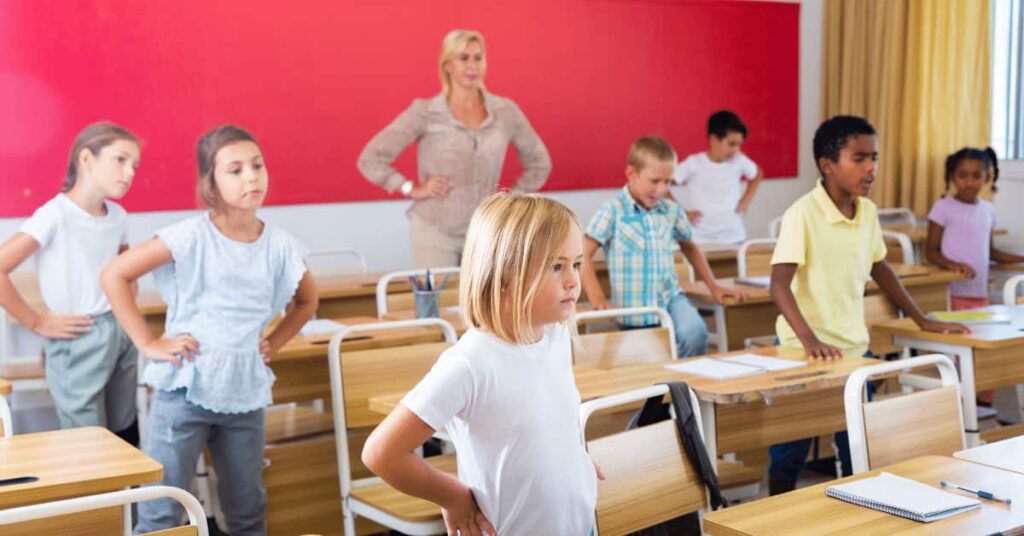
Mindfulness or deep breathing may also be beneficial. However, some anxious individuals may experience so-called relaxation-induced anxiety, which describes an increase in arousal following attempts to relax.
Therefore, be wary of this phenomenon.
(7) Divide the class into smaller subgroups for certain tasks
Participating in large groups is often intimidating for people with social phobia.
However, reduce the size of the group and you might see some astounding changes in the way a socially anxious student gets involved with the task and their peers.
Providing affected students with this distinct social setting can allow them to actively contribute to the assignments and draw on their peculiar talents.
By having the subgroups assign a person to present their work to the rest of the class, the student is provided an additional opportunity for exposure.
However, make sure the affected kids are the ones who decide to do so and that they are not being forced by the rest of the group to expose their work.
(8) Do not let the students form subgroups by themselves
When dividing the class into various groups, do not let the students form the groups themselves.
Out of the fear of rejection, students with social anxiety often remain passive when subgroups are being formed.
Therefore, chances are that they are routinely left out in this process, which tends to reinforce their social phobia.
Instead, make sure you choose a system that mixes up the students and accommodates every single one in the classroom.
This way, the affected students get in touch with peers they may have never interacted with and feel more included.

(9) Address the topic directly with the student in a private and safe setting
Approaching the student and discussing how their social anxiety affects them in the classroom is a good strategy for many individuals.
You have to be careful, though, as many affected people feel highly ashamed of their SAD and feel embarrassed when others find out about it.
If you sense that you can talk to the student about it, try to do so in a way which does not overwhelm them.
Choose a safe setting, where no peers are present, and be careful and sensitive to the student’s reactions when you bring up the topic.
Demonstrate to the student that you care about their well-being, their academic achievements and their future, and let them know they have your full support.
Discuss your methodology and ask them about ways to make them feel more at ease during class.
Let them know that you will not put them on the spot or create uncomfortable situations on purpose.
At the same time, make sure they understand that the academic environment demands being seen and heard and that the student will need to put in effort from their end.
Communicate that you are there to help and that you are open to discuss any issues that may come up.
(10) Discuss special arrangements between you and the student
In some cases, it can be helpful to come up with certain agreements that can help the student feel more comfortable during class and help them work on their social anxiety.
For example, you may promise to not call upon the student if they do not raise their hand. In exchange, the student promises to participate at least once every class.
You may also come up with a signal the student can use whenever they feel overwhelmed, so you can adjust the situation to take the edge off their anxiety.
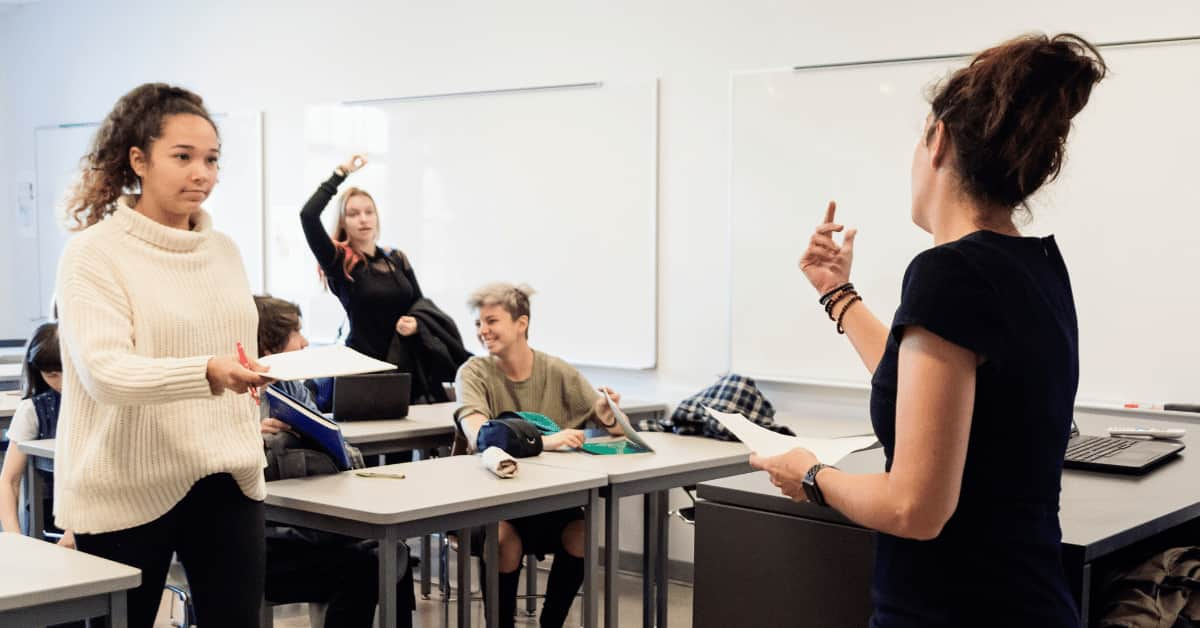
Some students benefit from being allowed to leave the classroom whenever they are overwhelmed. Such breaks can be covered up as trips to the restroom.
Lastly, make sure you come up with a strategy to provide the student with recurrent opportunities for exposure.
Discuss what situations frighten the student the most. Once identified, let the student know that you will create these situations on a small scale.
For example, a student afraid of reading out loud might benefit from you providing opportunities to read small parts of a text. Make sure the student knows that they can decide themselves to do so and that they will not be forced.
(11) Establish rules and agreements as well as a safety sign with the whole class
Ideally in the first class of a new school year or semester, ask the students if they can imagine any possible behaviors of their peers that would impede that they feel safe in the group.
Ask them about their values and what makes them feel at ease in group settings.
Like this, the students can come up with behavioral guidelines and rules that ensure a safe learning environment for everyone. A non-bullying policy should certainly be part of this.
Make sure the students agree upon not discriminating each other and to respect their differences.

The group can come up with a sign that indicates that someone feels the rules have been broken and which can be applied at any moment.
This way, students with social anxiety will feel much safer. Not only because of the established agreements, but also because they are likely to see that their peers have their own insecurities.
(12) Use activities in which the students share vulnerabilities
In a similar fashion, you may incorporate classroom activities that encourage the students to share their weak spots, such as their fears or things they usually do not share with others.
This type of activity is not suited for every group, as bullies may use the information disclosed by their peers against them.
However, if you have established rules of conduct and a non-discrimination policy, the students may benefit greatly from such activities.
For young people, it can be incredibly alleviating to realize that their peers struggle with similar insecurities as themselves.
For students with social anxiety, this can be a powerful experience, which can ease their distress in the group.
(13) Encourage Gradual Exposure
We have mentioned the importance of exposure before. Professional treatment for social anxiety disorder usually encapsulates that the patient faces the feared social situations in one way or another.
Despite agreeing upon going easy on the student, it is important that some form of exposure forms part of the classroom activities.
That is, the student needs to understand that gradually facing their fears is a powerful tool to decrease their anxiety and to move forward.

Motivate the student to routinely jump into the cold water. They need to understand that in order to receive the benefit of special agreements from your side, they need to put in courage and effort from their end.
Frequent, gradual exposure to the feared social situations is the most powerful way to reduce social anxiety for most affected individuals.
(14) Refer the student to a school counselor
If you sense that the student’s social anxiety overwhelms them, refer them to the school or university counselor.
Social phobia is a mental health condition which often requires professional help. A good school counselor will refer the student to a psychotherapist or suitable treatment facility.
While this may be initially difficult to digest for the student, chances are that they will be eternally grateful for your referral.
(15) Discuss and work through the issue with the student’s parents
A common issue among young people with social anxiety disorder is that they either keep their condition hidden from their parents or that these do not realize the extent of their child’s problem.
Both of these scenarios can have further detrimental effects on the student’s mental health.
If you have managed to establish a connection with the student and you are able to discuss their SAD openly, ask them whether or not their parents know about their social phobia and identify their position regarding it.
If the student has not told them, you may want to encourage them to do so. Offer the student your support in this matter.
If the parents disregard their child’s social anxiety as insignificant or as a phase that will pass by itself, offer the student to arrange a meeting between you and their parents to discuss the seriousness of the problem.
To such a meeting, you may want to invite a school counselor as well.
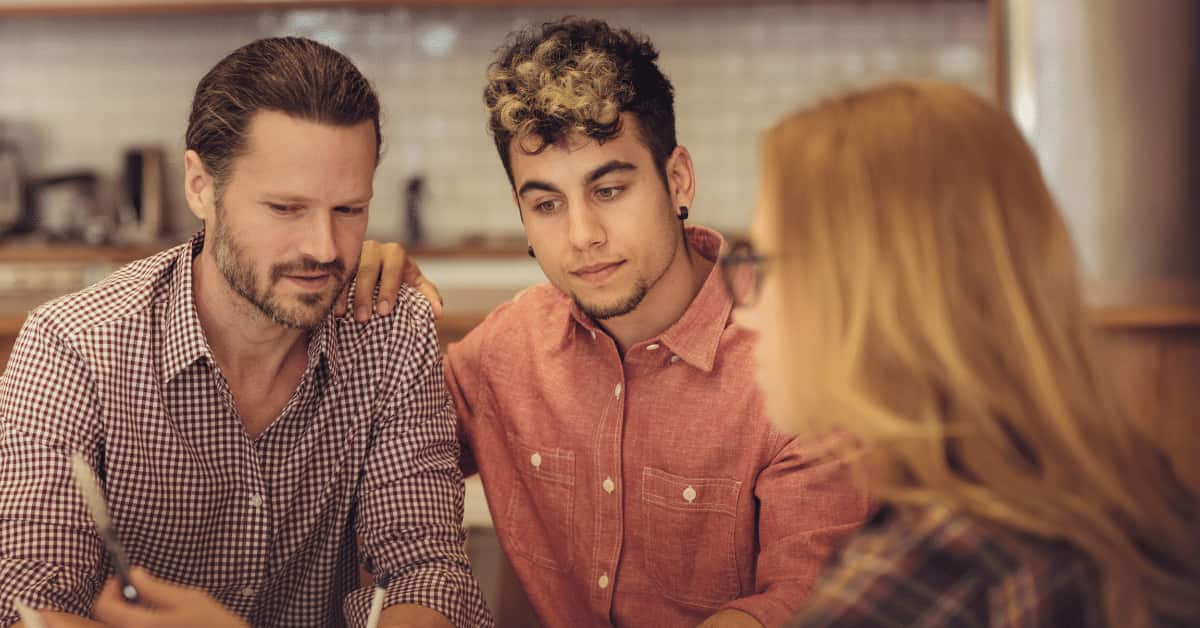
We hope this guide is of help to you and that you can offer your students the support they need.
If you have any further questions, please leave your comments below. We will try to get back to you as soon as we can.
To learn more about social anxiety and the available treatment options, head over to our complete treatment guide and have a look at our eBook Effective Psychotherapies for Social Anxiety.
We strive to provide an all-encompassing resource with this website – thanks for spreading the word!
Your Student Can Participate in a Research Study!
If you have a student who is affected by social anxiety, she or he can help researchers and clinicians better understand the condition and improve treatment efficacy by participating in a research study.
To take part, they can click here to open a short, quick survey in a new browser window, or simply fill out the form provided below. Thanks for participating!
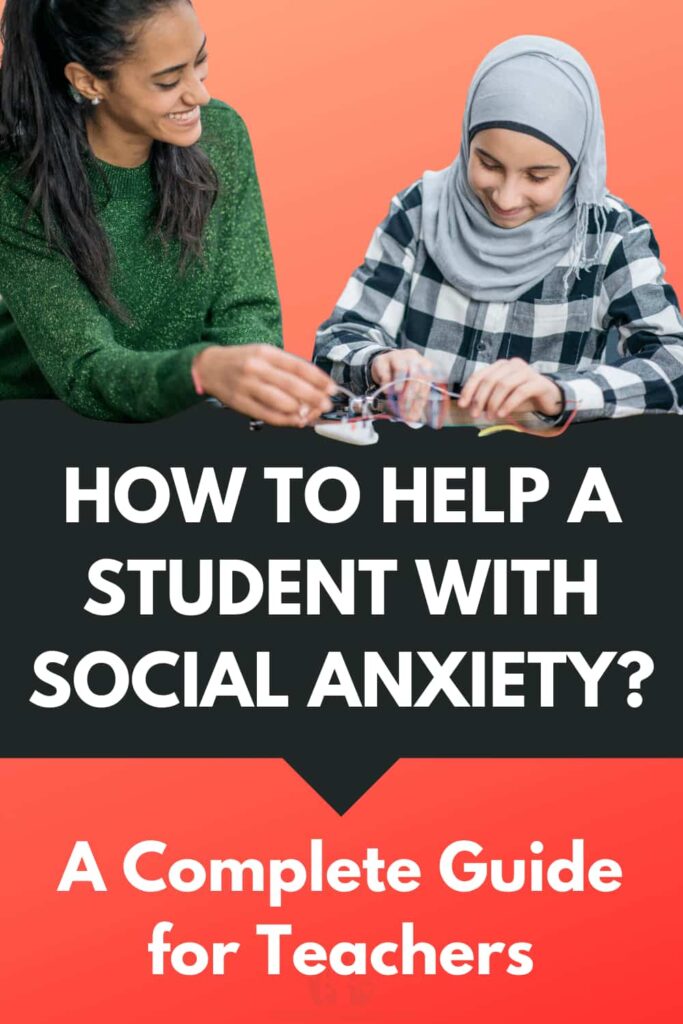
Pin | Share | Follow
[DISPLAY_ULTIMATE_SOCIAL_ICONS]
American Psychiatric Association. (2013). Diagnostic and statistical manual of mental disorders (5th ed.). Arlington, VA: American Psychiatric Publishing.
Beidel, D. C., Turner, S. M., & Morris, T. L. (1995). A new inventory to assess childhood social anxiety and phobia: The Social Phobia and Anxiety Inventory for Children. Psychological Assessment, 7(1), 73–79. https://doi.org/10.1037/1040-3590.7.1.73
Beidel, D. C., Turner, S. M., & Morris, T. L. (1999). Psychopathology of childhood social phobia. Journal of the American Academy of Child and Adolescent Psychiatry, 38(6), 643–650. https://doi.org/10.1097/00004583-199906000-00010
Chavira, D. A., Stein, M. B., Bailey, K., & Stein, M. T. (2004). Child anxiety in primary care: prevalent but untreated. Depression and anxiety, 20(4), 155–164. https://doi.org/10.1002/da.20039
Connolly, S. D., Bernstein, G. A., & Work Group on Quality Issues (2007). Practice parameter for the assessment and treatment of children and adolescents with anxiety disorders. Journal of the American Academy of Child and Adolescent Psychiatry, 46(2), 267–283. https://doi.org/10.1097/01.chi.0000246070.23695.06
Essau, C. A., Conradt, J., & Petermann, F. (1999). Frequency and comorbidity of social phobia and social fears in adolescents. Behaviour research and therapy, 37(9), 831–843. https://doi.org/10.1016/s0005-7967(98)00179-x
Kashdan, T. B., & Herbert, J. D. (2001). Social anxiety disorder in childhood and adolescence: current status and future directions. Clinical child and family psychology review, 4(1), 37–61. https://doi.org/10.1023/a:1009576610507
Kessler, R. C., Berglund, P., Demler, O., Jin, R., Merikangas, K. R., & Walters, E. E. (2005). Lifetime prevalence and age-of-onset distributions of DSM-IV disorders in the National Comorbidity Survey Replication. Archives of general psychiatry, 62(6), 593–602. https://doi.org/10.1001/archpsyc.62.6.593
Kessler, R. C., Stang, P., Wittchen, H. U., Stein, M., & Walters, E. E. (1999). Lifetime co-morbidities between social phobia and mood disorders in the US National Comorbidity Survey. Psychological medicine, 29(3), 555–567. https://doi.org/10.1017/s0033291799008375
Masia, C. L., Klein, R. G., Storch, E. A., & Corda, B. (2001). School-based behavioral treatment for social anxiety disorder in adolescents: results of a pilot study. Journal of the American Academy of Child and Adolescent Psychiatry, 40(7), 780–786. https://doi.org/10.1097/00004583-200107000-00012
Mekuria, K., Mulat, H., Derajew, H., Mekonen, T., Fekadu, W., Belete, A., Yimer, S., Legas, G., Menberu, M., Getnet, A., & Kibret, S. (2017). High Magnitude of Social Anxiety Disorder in School Adolescents. Psychiatry journal, 2017, 5643136. https://doi.org/10.1155/2017/5643136
Merikangas, K. R., He, J. P., Burstein, M., Swendsen, J., Avenevoli, S., Case, B., Georgiades, K., Heaton, L., Swanson, S., & Olfson, M. (2011). Service utilization for lifetime mental disorders in U.S. adolescents: results of the National Comorbidity Survey-Adolescent Supplement (NCS-A). Journal of the American Academy of Child and Adolescent Psychiatry, 50(1), 32–45. https://doi.org/10.1016/j.jaac.2010.10.006
Pöhlmann, K., Döbbel, S., Löffler, S., Israel, M., & Joraschky, P. (2009). Die Sozialphobie als blinder Fleck: Klinisch unterdiagnostiziert, hoher Schweregrad und ungünstiger Verlauf? [Social phobia – the blind spot: infrequently diagnosed, highly complex, and a predictor for unfavourable therapy outcomes?]. Zeitschrift fur Psychosomatische Medizin und Psychotherapie, 55(2), 180–188. https://doi.org/10.13109/zptm.2009.55.2.180
Ruscio, A. M., Brown, T. A., Chiu, W. T., Sareen, J., Stein, M. B., & Kessler, R. C. (2008). Social fears and social phobia in the USA: results from the National Comorbidity Survey Replication. Psychological medicine, 38(1), 15–28. https://doi.org/10.1017/S0033291707001699
Ryan, J. L., & Warner, C. M. (2012). Treating adolescents with social anxiety disorder in schools. Child and adolescent psychiatric clinics of North America, 21(1), 105–ix. https://doi.org/10.1016/j.chc.2011.08.011
Sonntag, H., Wittchen, H. U., Höfler, M., Kessler, R. C., & Stein, M. B. (2000). Are social fears and DSM-IV social anxiety disorder associated with smoking and nicotine dependence in adolescents and young adults?. European psychiatry : the journal of the Association of European Psychiatrists, 15(1), 67–74. https://doi.org/10.1016/s0924-9338(00)00209-1
Van Ameringen, M., Mancini, C., & Farvolden, P. (2003). The impact of anxiety disorders on educational achievement. Journal of anxiety disorders, 17(5), 561–571. https://doi.org/10.1016/s0887-6185(02)00228-1
Wittchen H. U. (2000). The many faces of social anxiety disorder. International clinical psychopharmacology, 15 Suppl 1, S7–S12. https://doi.org/10.1097/00004850-200007001-00003
Wunderlich, U., Bronisch, T., & Wittchen, H.-U. (1998). Comorbidity patterns in adolescents and young adults with sucide attempts. European Archives of Psychiatry and Clinical Neuroscience, 248(2), 87–95. https://doi.org/10.1007/s004060050023
Yonkers, K. A., Bruce, S. E., Dyck, I. R., & Keller, M. B. (2003). Chronicity, relapse, and illness–course of panic disorder, social phobia, and generalized anxiety disorder: findings in men and women from 8 years of follow-up. Depression and anxiety, 17(3), 173–179. https://doi.org/10.1002/da.10106
Yonkers, K. A., Dyck, I. R., & Keller, M. B. (2001). An eight-year longitudinal comparison of clinical course and characteristics of social phobia among men and women. Psychiatric services (Washington, D.C.), 52(5), 637–643. https://doi.org/10.1176/appi.ps.52.5.637

About the Author: Martin Stork
Martin is a professional psychologist with a background in physical therapy. He has organized and led various support groups for people with social anxiety in Washington, DC and Buenos Aires, Argentina. He is the founder of Conquer Social Anxiety Ltd, where he operates as a writer, therapist and director. You can click here to find out more about Martin.







